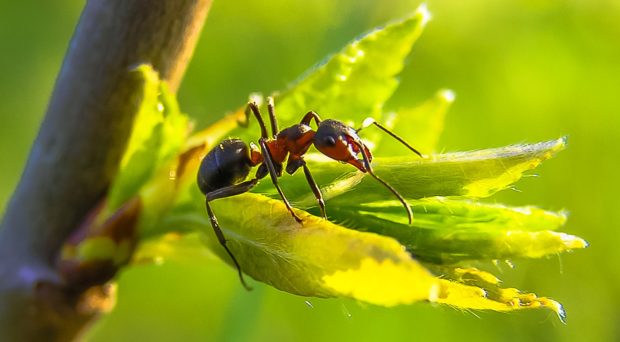
When exploring forests of Central and South America it is common to stumble across highways of countless ants transporting large chunks of plant material. These are leaf-cutting ants, the dominant herbivores of the Neotropics, collecting leaves and flowers they feed to a fungus crop they cultivate in underground chambers.
This symbiosis is similar to our own agriculture in many ways: the ants are obligately dependent on the fungus for food, they fertilize it using material they collect, and even use antibiotics to treat fungus garden diseases.
This mutualistic relationship has long drawn the attention of scientists trying to understand the evolutionary dynamics of cooperation between organisms across kingdoms of life. However, these ants are also fascinating because of their unique mating biology, and because the queens are extraordinarily long-lived.
Mating idiosyncrasies of leaf-cutting ants
A queen can live for two or three decades, during which she will never re-mate, but will prudently use the sperm from these males to fertilize millions of eggs.
Leaf-cutting ant queens mate during a single mating event early in adult life. When a queen embarks on a mating flight, she will mate with multiple male partners, and return to the ground to shed her wings and seek a suitable place to burrow a nest.
Yet while the males drop dead almost immediately after they have delivered sperm to queens, a queen can live for two or three decades, during which she will never re-mate, but will prudently use the sperm from these males — stored in a specialized organ called the spermatheca — to fertilize millions of eggs.
Such lengthy sperm storage represents a record in the animal kingdom, and creates an exceptional lifetime commitment between partners — it would be analogous to vertebrate females being constantly pregnant with sperm of a few males that need to be kept alive at ambient temperature and protected from senescence mechanisms for years after the male partners are dead and gone.
Since multiple males inseminate a leaf-cutting ant queen in a single afternoon, the spermatozoa of different males compete for storage in the queen spermatheca. This interplay between competition for storage and the need to remain alive for many years after storage has created unique evolutionary adaptations in ant sperm.
Unravelling reproductive conflicts in ants
Fertility research in vertebrates has firmly established that sperm are capable of responding to subtle changes in their surroundings, allowing them to reach and fertilize female eggs more effectively. These can be changes in pH, ion concentrations or temperature of reproductive tracts and glandular secretions, or the presence of specific molecules that attract sperm to fertilization sites.
By adapting an experimental procedure to quantify sperm motility normally used in vertebrate studies, we discovered that ant sperm are able to do the same: not only do a greater proportion of sperm become motile and swim faster when in contact with secretions of male and queen reproductive organs, but they do so differently depending on whether these secretions belong to themselves, or to queens and rival males.
We first noticed that when ejaculates from different males are mixed, sperm motility increases compared to when the same ejaculates swim individually. To identify the factors inducing these increases, we performed additional experiments by collecting sperm from a focal male and making them swim in seminal fluid from the same male, from a rival male, or in secretions from different compartments of the queen reproductive organs, as well as mixes of these various fluids.
We found that, compared to a saline control, the seminal fluid that is ejaculated together with sperm enhanced motility, and that motility was further increased as soon as these sperm came into contact with either the seminal fluid of a rival male or fluid contained in a queen’s spermatheca.
Since, from the perspective of the focal sperm, both the rival male seminal fluid and queen spermathecal fluid are secretions from non-self tissue, we concluded that the sperm must respond to molecules present in non-self secretions and regulate motility accordingly — a response that makes sense when the presence of rival ejaculates means that racing for storage will increase a male’s reproductive success.
Why do sperm differentiate between own and alien secretions?
Sperm could potentially become maximally mobile as soon as they are inseminated in a queen, independently of the presence of any competing sperm, so why do they swim slower in their own seminal fluid? Expressing a recognition mechanism to differentiate between self and non-self is presumably costly, so our observations require an evolutionary explanation.
There may be a trade-off between the increased motility required to win the competitive race for storage and the long-term survival of sperm once they are in storage.
We hypothesize that this recognition evolved because sustaining sperm motility is energetically expensive and leads to the production of reactive oxygen species (ROS). Sperm are particularly susceptible to structural damage incurred by ROS because they lack extensive damage repair mechanisms, meaning that any increase in ROS will likely lead to irreversible loss of sperm fertilization capacity.
Thus, there may be a trade-off between the increased motility required to win the competitive race for storage and the long-term survival of sperm once they are in storage — important because it may be many years before they are used to fertilize eggs.
Data from multiple studies suggest ROS damage control is a key factor in maintaining sperm viability — queens of multiple ant and bee species upregulate anti-oxidative enzymes after sperm storage, and these enzymes are also abundant in their seminal fluid.
Thus, to shed further light upon the evolutionary dilemma of how ants ensure long-term sperm survival in spite of costly sperm competition, future research should try to measure the ROS production associated with sperm motility more explicitly.
Why illustrate an article about leaf-cutting ants with a picture of a wood ant?